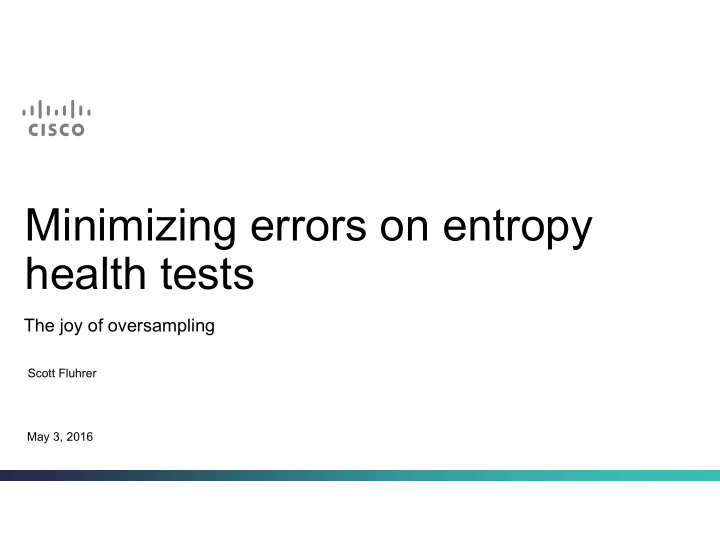



Minimizing errors on entropy health tests The joy of oversampling Scott Fluhrer May 3, 2016
Agenda NIST Health Test Model Positive and Negative Failures A Better Way Recommendations 2
NIST Entropy Health Test Model (simplified) Noise Source Health Tests Raw Data Output Error Message 3
Reasons we run Health Tests Unlike the rest of the system, Known Answer Tests don’t work on noise sources. We run Health Tests to verify that the noise source is functioning properly: To catch degrading hardware Infant failures or hardware that’s past its ‘best-by’ date To catch environmental-based attacks An attacker may be chilling the entire system to -40 ○ 4
Potential Failures in this System False Negatives Not detecting a problem when there is one Obviously, it is important to minimize this possibility False Positives Claiming there is a problem on a working system We’d like to minimize this as well 5
False Positives To keep the false negative probability low, the current 800-90B draft asks that the false positive rate be at least 2 -50 This may appear to be an acceptably low probability, except: There may be billions of IOT devices Each device may access its entropy source many times over its lifetime Slightly degraded devices may have a significantly higher rate of false positives 6
Problems with False Positives A high rate of false positives means that the manufacturers will try to just log an error and continue running Error messages have a high likelihood of being ignored A high false positive rate will mean that service personnel will ignore these errors If these problems were required to have a low false negative rate, this would be an acceptable trade-off. 7
NIST Model vs Proposed New Model IID Nominal Entropy Rate H I No Entropy NIST Model 8
NIST Model vs Proposed New Model IID IID Nominal Nominal Entropy Entropy Rate H I Rate H I No Entropy No Entropy NIST Model Proposed Model 9
NIST Model vs Proposed New Model IID IID Nominal Nominal Entropy Entropy Rate H I Rate H I Health Test Entropy Rate H HT No Entropy No Entropy NIST Model Proposed Model 10
NIST Model vs Proposed New Model IID IID Nominal Nominal Entropy Entropy Rate H I Rate H I Health Test Entropy Rate H HT Consumer Entropy Rate H C No Entropy No Entropy NIST Model Proposed Model 11
Entropy Parameters H I Nominal Entropy Rate (as Current) H HT Entropy Rate Used for Health Tests H C Entropy Rate Given to Consumer H I > H HT improves false positive rate H HT > H C improves false negative rate 12
What are the costs? Low false positive and false negative rate – what could be wrong? This uses more entropy samples than required Why isn’t this a deal-breaker? Well, in some environments, sampling the entropy source is cheap It’s not that much more This also assumes a health test that will actually catch problems 13
Recommendations NIST should explicitly allow developers to tune their health tests for an entropy rate lower than H I This is so that a reference lab will not decide to reject it NIST should allow developers the option to use H I , H HT , H C (and document the values they declare). This is so buyers of noise sources can make more informed decisions More research on better health tests 14
Thank you.
Recommend
More recommend